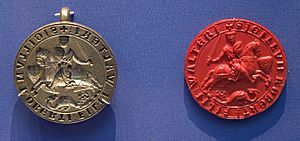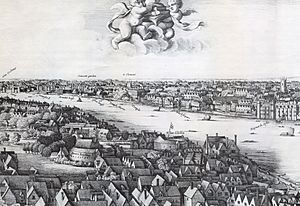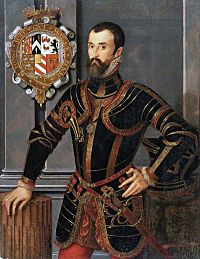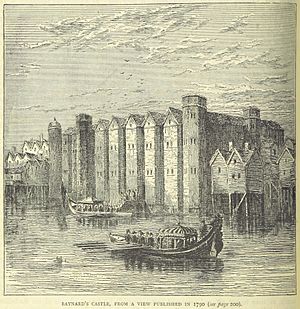Baynard's Castle facts for kids
Quick facts for kids Baynard's Castle |
|
|---|---|
| Part of the Fortifications of London | |
| Blackfriars, London, England, UK | |
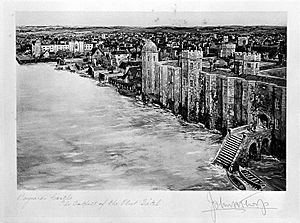
The first Baynard's Castle
|
|
| Lua error in Module:Location_map at line 420: attempt to index field 'wikibase' (a nil value). | |
| Type | Castle, later mansion |
| Site history | |
| Built | Before 1017 |
| Materials | stone |
| Demolished | 1666 |
| Garrison information | |
| Occupants | English royalty |
Baynard's Castle was the name for two important buildings in London, England. They were located near where Blackfriars Station and St Paul's Cathedral are today. The first was a strong Norman castle built by Ralph Baynard around 1086. This castle was torn down by King John in 1213.
The second building was a grand medieval palace. It was built a bit further southeast from the first castle. This palace was destroyed in the Great Fire of London in 1666. Historians say that Baynard's Castle was one of the most interesting houses in London.
Contents
The First Baynard's Castle: A Norman Fort
The very first Baynard's Castle was built in a very important spot. It was where the old Roman city walls and the River Fleet met the River Thames. This was just east of today's Blackfriars Station.
The River Fleet is now mostly underground, but long ago it was a large river. Because of its location, this area was likely used as a fort even before the Normans arrived. Some stories say that King Canute stayed at a fort here in 1017.
Who Built the First Castle?
After the Norman conquest of England in 1066, a follower of William the Conqueror named Ralph Baynard rebuilt this fort. It was located right on the riverbank, inside the Roman walls. Another Norman fort, Montfichet's Tower, was only about 70 meters north.
Archaeologists have found parts of the old castle's defenses. These stretched south from what is now Queen Victoria Street. The castle was passed down through Ralph Baynard's family.
Why Was the First Castle Destroyed?
The castle was eventually inherited by William Baynard. However, he lost his lands early in the reign of King Henry I. This happened because William supported Henry's brother, Robert Curthose, who also wanted to be king.
Later, the castle and its surrounding area were given to Robert Fitz Richard. His grandson, Robert Fitzwalter, became the leader of a group of barons who rebelled against King John. This rebellion led to the famous Magna Carta in 1215.
King John found out about Fitzwalter's plans. So, on January 14, 1213, King John ordered Baynard's Castle to be destroyed. Fitzwalter was later forgiven, and he was allowed to repair his castles. However, in 1275, the site was sold to the Archbishop of Canterbury. It was then used to build the large Dominican Priory at Blackfriars.
Special Rights of the Castle Lord
The lord of Baynard's Castle had a very special role in London. Robert Fitzwalter tried many times to keep these special rights even after selling the castle site.
What Were These Privileges?
The main claim was to be the "Chief Banneret" of London. This meant the lord of Baynard's Castle could carry the banner of the City of London into battle. This made them a leader of London's forces.
In peaceful times, the area around Baynard's Castle had its own court. This court would sentence criminals who were found guilty at the Guildhall. It even had its own prison. This special role combined military leadership with legal power.
The New Baynard's Castle: A Royal Palace
About a century after the first castle was destroyed, a new mansion was built. This new building was on land that had been reclaimed from the River Thames. It was about 100 meters southeast of the original castle's site. Even though it was a new building, people still called it Baynard's Castle.
A Home for Royalty
This new house was rebuilt after a big fire in 1428. It became the main London home for the House of York during the Wars of the Roses. This was a series of wars fought over who should be king of England.
- King Edward IV was declared king in the castle's great hall.
- Later, King Richard III was also crowned here. This event is even mentioned in Shakespeare's play Richard III.
The Tudors and Beyond
King Henry VII rebuilt the house again around the end of the 15th century. He made it more beautiful and suitable for a prince. His son, Henry VIII, gave the castle to his first wife, Catherine of Aragon, just before their wedding in 1509.
In 1551, the house was given to William Herbert, Earl of Pembroke. It was at Baynard's Castle that the Privy Council met to declare Mary as Queen of England. Pembroke made the house even bigger, adding a second courtyard.
During the Civil War, the Herbert family supported Parliament. After the monarchy was restored in 1660, the house was occupied by Francis Talbot, Earl of Shrewsbury, who had supported the King.
Baynard's Castle After the Great Fire
Baynard's Castle was destroyed in the terrible Great Fire of London in 1666. After the fire, many ruins remained, especially the stone front facing the river. However, by 1720, only a round tower was left. This tower was later turned into a home.
Over time, the rest of the castle site became timber yards and wharves. The last remaining tower was pulled down in the 1800s to make way for new buildings.
What Stands There Today?
In the 1970s, the area was redeveloped. A large office building called "Baynard House" was built on the site. This building is used by the telephone company BT Group.
Most of the land under Baynard House is now a protected historical site. The castle's history is remembered by street names like Castle Baynard Street and the Castle Baynard Ward in the City of London.
Discovering the Past: Archaeology
Most of what we know about the second Baynard's Castle comes from archaeological digs. These happened between 1972 and 1975, before Baynard House was built.
Archaeologists found parts of the castle's north side, including a gate and gate tower. They also found two east-west walls. The castle was built on land that had been reclaimed from the river. Its foundations were made of chalk, ragstone, and mortar. More excavations in 1981 found the southeast corner tower of the Tudor castle.
Images for kids


